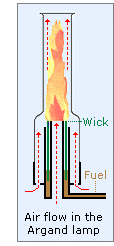 The "Lewis
Lamp" as it came to be known in its application in Great Lakes
lighthouses actually refers to a combination of two technologies, and is
a story of some intrigue. The story began in 1781, when thirty-one year old Swiss physicist
and chemist Aimé Argand designed a new type of lamp in which a single
wick was able to emit as much light as seven candles. The "Lewis
Lamp" as it came to be known in its application in Great Lakes
lighthouses actually refers to a combination of two technologies, and is
a story of some intrigue. The story began in 1781, when thirty-one year old Swiss physicist
and chemist Aimé Argand designed a new type of lamp in which a single
wick was able to emit as much light as seven candles.
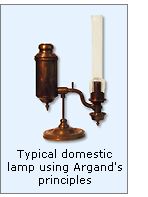 Argand's design featured the incorporation of hollow cylinder within the
circular wick, which allowed air to flow both inside and outside the
flame at the upper edge of the fuel-soaked wick. The addition of a
cylindrical glass chimney created greater draft, promoting steadiness in
the flame by preventing side draughts. Argand successfully
obtained a patent for this lamp while living in England in 1784, and
lamps built to his patent were quickly accepted throughout Europe, becoming the most common illumination in both public buildings and
private homes. Argand's design featured the incorporation of hollow cylinder within the
circular wick, which allowed air to flow both inside and outside the
flame at the upper edge of the fuel-soaked wick. The addition of a
cylindrical glass chimney created greater draft, promoting steadiness in
the flame by preventing side draughts. Argand successfully
obtained a patent for this lamp while living in England in 1784, and
lamps built to his patent were quickly accepted throughout Europe, becoming the most common illumination in both public buildings and
private homes.
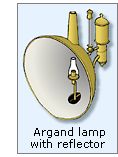 There is
some disagreement as to who was the first to place
parabolic reflectors behind Argand's lamp to further boost and
concentrate the output. H L. Reynaud, Director of the French Lighthouse
Service, credited Aimé Argand himself
with the first proposal for an apparatus using an Argand lamp and a
reflector. This
combination represented a considerable improvement over current
illumination systems, and quickly came into widespread use in European
lighthouses. However, the incorporation of Argand's lamp technology with parabolic reflectors
in US lighthouses is attributed to Winslow Lewis, and it is here that
the story takes an interesting turn. There is
some disagreement as to who was the first to place
parabolic reflectors behind Argand's lamp to further boost and
concentrate the output. H L. Reynaud, Director of the French Lighthouse
Service, credited Aimé Argand himself
with the first proposal for an apparatus using an Argand lamp and a
reflector. This
combination represented a considerable improvement over current
illumination systems, and quickly came into widespread use in European
lighthouses. However, the incorporation of Argand's lamp technology with parabolic reflectors
in US lighthouses is attributed to Winslow Lewis, and it is here that
the story takes an interesting turn.
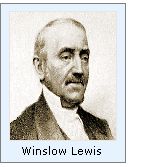 In 1812, Stephen Pleasonton, the Fifth Auditor of the Treasury purchased
a patented "reflecting and magnifying lantern" from Winslow
Lewis, a former ship Captain. Lewis' reflective optic was made of ten
whale oil-burning lamps, each outfitted with a parabolic reflector. In reality, Lewis' "invention" was nothing more than a poorly
modified version of the Argand-style lamp. Lewis' lights were also severely flawed,
in that their reflectors were more spherical than parabolic, and made of
thin copper that warped when exposed to the heat of illumination.
Additionally, the silver plating rubbed off easily during cleaning, and
the components were so shoddily cobbled together that the assemblies quickly
began to fall apart. Finally, the design of the drafting flow was less
than optimal, with the entire assembly prone to sooting-up very quickly.
Thus the
lamps required constant cleaning and adjustment.
In 1812, Stephen Pleasonton, the Fifth Auditor of the Treasury purchased
a patented "reflecting and magnifying lantern" from Winslow
Lewis, a former ship Captain. Lewis' reflective optic was made of ten
whale oil-burning lamps, each outfitted with a parabolic reflector. In reality, Lewis' "invention" was nothing more than a poorly
modified version of the Argand-style lamp. Lewis' lights were also severely flawed,
in that their reflectors were more spherical than parabolic, and made of
thin copper that warped when exposed to the heat of illumination.
Additionally, the silver plating rubbed off easily during cleaning, and
the components were so shoddily cobbled together that the assemblies quickly
began to fall apart. Finally, the design of the drafting flow was less
than optimal, with the entire assembly prone to sooting-up very quickly.
Thus the
lamps required constant cleaning and adjustment.
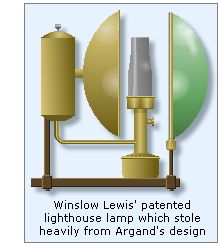 Despite such problems,
Lewis' lamps were quickly adopted by Pleasonton as the de facto standard,
and
were subsequently installed in all US Lighthouses prior to 1852. Despite such problems,
Lewis' lamps were quickly adopted by Pleasonton as the de facto standard,
and
were subsequently installed in all US Lighthouses prior to 1852.
It is interesting to note that Pleasonton had previously served at the
US patent office, and was working there at the time that Lewis applied for his patent.
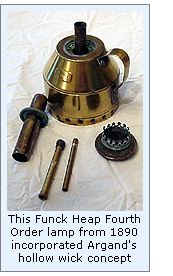 From his business on State Street in Boston, Captain Winslow Lewis accumulated his wealth as the
"Superintendent for lighting the United States light houses," and
by the end of 1812, Lewis had received at least $16,000 from the U.S. government in
payment for installing his Argand devices in
lighthouses.
From his business on State Street in Boston, Captain Winslow Lewis accumulated his wealth as the
"Superintendent for lighting the United States light houses," and
by the end of 1812, Lewis had received at least $16,000 from the U.S. government in
payment for installing his Argand devices in
lighthouses.
When French scientist Augustin Fresnel installed a lens that produced a
light infinitely superior to Lewis' system in 1823, Pleasonton resisted
testing the new lens until forced to do so as a result of a
Congressional investigation onto the efficiency of lighthouse
operations. Evan after the completion of highly successful tests of the
Fresnel lens, the lens was not adopted in this
country until the administration of aids to navigation was taken out of
Pleasonton's hands and assigned to the U.S. Lighthouse Board in 1853.
However, Argand's hollow wick system
outlived either he or Lewis, as the concept would remain in active use
until the perfection of the incandescent oil vapor lamp lamp in the
early twentieth century.

|
 The "Lewis
Lamp" as it came to be known in its application in Great Lakes
lighthouses actually refers to a combination of two technologies, and is
a story of some intrigue. The story began in 1781, when thirty-one year old Swiss physicist
and chemist Aimé Argand designed a new type of lamp in which a single
wick was able to emit as much light as seven candles.
The "Lewis
Lamp" as it came to be known in its application in Great Lakes
lighthouses actually refers to a combination of two technologies, and is
a story of some intrigue. The story began in 1781, when thirty-one year old Swiss physicist
and chemist Aimé Argand designed a new type of lamp in which a single
wick was able to emit as much light as seven candles. Argand's design featured the incorporation of hollow cylinder within the
circular wick, which allowed air to flow both inside and outside the
flame at the upper edge of the fuel-soaked wick. The addition of a
cylindrical glass chimney created greater draft, promoting steadiness in
the flame by preventing side draughts. Argand successfully
obtained a patent for this lamp while living in England in 1784, and
lamps built to his patent were quickly accepted throughout Europe, becoming the most common illumination in both public buildings and
private homes.
Argand's design featured the incorporation of hollow cylinder within the
circular wick, which allowed air to flow both inside and outside the
flame at the upper edge of the fuel-soaked wick. The addition of a
cylindrical glass chimney created greater draft, promoting steadiness in
the flame by preventing side draughts. Argand successfully
obtained a patent for this lamp while living in England in 1784, and
lamps built to his patent were quickly accepted throughout Europe, becoming the most common illumination in both public buildings and
private homes.
 There is
some disagreement as to who was the first to place
parabolic reflectors behind Argand's lamp to further boost and
concentrate the output. H L. Reynaud, Director of the French Lighthouse
Service, credited Aimé Argand himself
with the first proposal for an apparatus using an Argand lamp and a
reflector. This
combination represented a considerable improvement over current
illumination systems, and quickly came into widespread use in European
lighthouses. However, the incorporation of Argand's lamp technology with parabolic reflectors
in US lighthouses is attributed to Winslow Lewis, and it is here that
the story takes an interesting turn.
There is
some disagreement as to who was the first to place
parabolic reflectors behind Argand's lamp to further boost and
concentrate the output. H L. Reynaud, Director of the French Lighthouse
Service, credited Aimé Argand himself
with the first proposal for an apparatus using an Argand lamp and a
reflector. This
combination represented a considerable improvement over current
illumination systems, and quickly came into widespread use in European
lighthouses. However, the incorporation of Argand's lamp technology with parabolic reflectors
in US lighthouses is attributed to Winslow Lewis, and it is here that
the story takes an interesting turn.  In 1812, Stephen Pleasonton, the Fifth Auditor of the Treasury purchased
a patented "reflecting and magnifying lantern" from Winslow
Lewis, a former ship Captain. Lewis' reflective optic was made of ten
whale oil-burning lamps, each outfitted with a parabolic reflector. In reality, Lewis' "invention" was nothing more than a poorly
modified version of the Argand-style lamp. Lewis' lights were also severely flawed,
in that their reflectors were more spherical than parabolic, and made of
thin copper that warped when exposed to the heat of illumination.
Additionally, the silver plating rubbed off easily during cleaning, and
the components were so shoddily cobbled together that the assemblies quickly
began to fall apart. Finally, the design of the drafting flow was less
than optimal, with the entire assembly prone to sooting-up very quickly.
Thus the
lamps required constant cleaning and adjustment.
In 1812, Stephen Pleasonton, the Fifth Auditor of the Treasury purchased
a patented "reflecting and magnifying lantern" from Winslow
Lewis, a former ship Captain. Lewis' reflective optic was made of ten
whale oil-burning lamps, each outfitted with a parabolic reflector. In reality, Lewis' "invention" was nothing more than a poorly
modified version of the Argand-style lamp. Lewis' lights were also severely flawed,
in that their reflectors were more spherical than parabolic, and made of
thin copper that warped when exposed to the heat of illumination.
Additionally, the silver plating rubbed off easily during cleaning, and
the components were so shoddily cobbled together that the assemblies quickly
began to fall apart. Finally, the design of the drafting flow was less
than optimal, with the entire assembly prone to sooting-up very quickly.
Thus the
lamps required constant cleaning and adjustment.  Despite such problems,
Lewis' lamps were quickly adopted by Pleasonton as the de facto standard,
and
were subsequently installed in all US Lighthouses prior to 1852.
Despite such problems,
Lewis' lamps were quickly adopted by Pleasonton as the de facto standard,
and
were subsequently installed in all US Lighthouses prior to 1852. From his business on State Street in Boston, Captain Winslow Lewis accumulated his wealth as the
"Superintendent for lighting the United States light houses," and
by the end of 1812, Lewis had received at least $16,000 from the U.S. government in
payment for installing his Argand devices in
lighthouses.
From his business on State Street in Boston, Captain Winslow Lewis accumulated his wealth as the
"Superintendent for lighting the United States light houses," and
by the end of 1812, Lewis had received at least $16,000 from the U.S. government in
payment for installing his Argand devices in
lighthouses.